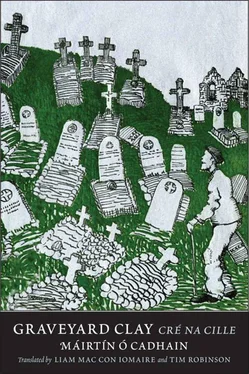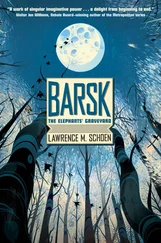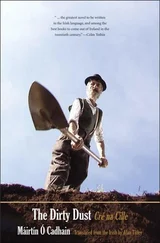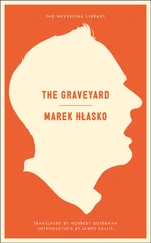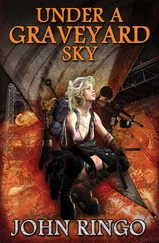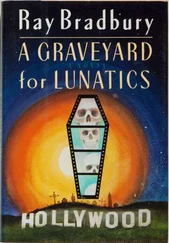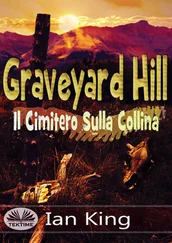Máirtín Ó Cadhain - Graveyard Clay - Cré na Cille
Здесь есть возможность читать онлайн «Máirtín Ó Cadhain - Graveyard Clay - Cré na Cille» весь текст электронной книги совершенно бесплатно (целиком полную версию без сокращений). В некоторых случаях можно слушать аудио, скачать через торрент в формате fb2 и присутствует краткое содержание. Год выпуска: 2016, Издательство: Yale University Press, Жанр: Классическая проза, на английском языке. Описание произведения, (предисловие) а так же отзывы посетителей доступны на портале библиотеки ЛибКат.
- Название:Graveyard Clay: Cré na Cille
- Автор:
- Издательство:Yale University Press
- Жанр:
- Год:2016
- ISBN:нет данных
- Рейтинг книги:4 / 5. Голосов: 1
-
Избранное:Добавить в избранное
- Отзывы:
-
Ваша оценка:
- 80
- 1
- 2
- 3
- 4
- 5
Graveyard Clay: Cré na Cille: краткое содержание, описание и аннотация
Предлагаем к чтению аннотацию, описание, краткое содержание или предисловие (зависит от того, что написал сам автор книги «Graveyard Clay: Cré na Cille»). Если вы не нашли необходимую информацию о книге — напишите в комментариях, мы постараемся отыскать её.
is invariably ranked the most important prose work in modern Irish. This bold new translation of his radically original
is the shared project of two fluent speakers of the Irish of Ó Cadhain’s native region, Liam Mac Con Iomaire and Tim Robinson. They have achieved a lofty goal: to convey Ó Cadhain’s meaning accurately
to meet his towering literary standards.
Graveyard Clay
Graveyard Clay: Cré na Cille — читать онлайн бесплатно полную книгу (весь текст) целиком
Ниже представлен текст книги, разбитый по страницам. Система сохранения места последней прочитанной страницы, позволяет с удобством читать онлайн бесплатно книгу «Graveyard Clay: Cré na Cille», без необходимости каждый раз заново искать на чём Вы остановились. Поставьте закладку, и сможете в любой момент перейти на страницу, на которой закончили чтение.
Интервал:
Закладка:
During his internment he had been very successful in teaching spoken Irish to adults of very varied educational backgrounds. In the first of many letters Ó Cadhain wrote to his fellow Irish-language writer Tomás Bairéad in Dublin, he states (translated from the Irish): “There wasn’t a language spoken in Babel that isn’t being taught by us here: Irish, French, Spanish, German, Latin, Welsh, Breton…. There’s a fair amount of Irish speakers here, and every trade and faculty, except barbers!” 4A collection of those letters in Irish, twenty-three in all, was published by Sáirséal agus Dill, a small, bespoke publishing house in Dublin, entitled As an nGéibheann (Out of Captivity, 1973), leaving us a rich personal account of his years behind barbed wire. More personal references to his years in the Curragh Camp are available in TONE — Inné agus Inniu (TONE — Yesterday and Today), based on a lecture Ó Cadhain gave to the Wolfe Tone Association in the Mansion House, Dublin, in 1963, edited by Bernadette Ní Rodaigh and Eibhlín Ní Allúráin, published by Iontaobhas Uí Chadhain (the Ó Cadhain Trust) and Coiscéim in 1999. Both his father and his mother died during his years in captivity.
On his release in July 1944, Ó Cadhain was asked by the then Taoiseach (head of government), Éamon de Valera, to continue with his work on the English-Irish Dictionary . In 1945 he married Máirín Ní Rodaigh, a national teacher and fluent Irish speaker from Cavan, and a gifted teacher of Irish to the infant classes in Scoil Lorcáin in Monkstown in south Dublin for many years. They settled permanently in Dublin and had no children of their own.
In March 1947 Ó Cadhain was appointed to Rannóg an Aistriúcháin (the Parliamentary Translation Staff) in Dublin, which at the time had been given the task of forming a standardized spelling and morphology of Irish, based on the spoken dialects as well as on the written language. He made no small contribution to this difficult task, although, of course, his suggestions were not always adopted (as is evident in his article “Forbairt na Gaeilge” published in the monthly magazine Feasta in December 1951). His period with the Parliamentary Translation Staff provided him with valuable experience of the problems involved in the adaptation of a spoken rural language (with three major dialects) to the requirements of modern urban society.
His second collection of short stories, An Braon Broghach (The Cloudy Drop) was published in 1948, meriting the following praise from the writer and poet Eoghan Ó Tuairisc, who would later translate a selection of these stories into English: “One feels a certain exultation of spirit in his 1948 collection of stories: the born teacher discovering himself as the born writer.” 5
Cré na Cille ( Graveyard Clay ), Ó Cadhain’s third book and first novel, was published by Sáirséal agus Dill in 1950 to critical acclaim, and was serialised over a seven-month period in the national daily broadsheet newspaper the Irish Press . In the public lecture delivered to Cumann Merriman, Ó Cadhain said (translated from the Irish): “A few years after being set free I wrote Cré na Cille and another novel Athnuachan , which won the Club Leabhar Prize (1951). When I began writing Cré na Cille I felt confident that I could write a better novel than had previously been written in Irish.” 6 Cré na Cille was chosen by UNESCO as an outstanding work, with a recommendation that it be translated into other European languages, and Ó Cadhain was elected a member of the Royal Irish Academy, the first Irish-language writer to receive the honour.
Athnuachan (Renewal) remained unpublished, at the author’s own behest, until after his death. The writer and critic Tomás Ó Floinn, on behalf of a panel of judges appointed by An Club Leabhar (the Book Club), noted (translated from the Irish): “Nothing has been written in Irish to date that is as powerful, as moving, as certain chapters in this book … only a real artist could handle this subject as it has been handled here.” 7And when the book was eventually published by Iontaobhas Uí Chadhain (Coiscéim, 1995), the writer and critic Breandán Ó Doibhlin wrote in the preface (translated from the Irish): “I think it is no exaggeration to say that Athnuachan is on a par with Cré na Cille as far as its energy and force of dialogue is concerned, in its comic depiction of the utter absurdity of the human race.” 8
Ó Cadhain’s third volume of short stories, Cois Caoláire (By the Firth — that is, by Galway Bay), published by Sáirséal agus Dill in 1953, added further to his reputation and marked a new departure in his writing. The volume contained some earlier material that An Gúm had deemed unsuitable to include in An Braon Broghach , a decision that sufficiently rankled with Ó Cadhain for him to remark on Raidió Éireann several years later (on 11 May 1952) that his readers would be the ultimate arbiters on the isssue. The collection contained several searing studies set in Conamara, but it also marked a change in emphasis from the rural towards the urban and the suburban, which opened up a new canvas on which Ó Cadhain could examine the individual on the margins.
From 1953 to 1956, he contributed a weekly column to the Irish Times , and a collection of those articles entitled Caiscín (Brown Bread), edited by Aindrias Ó Cathasaigh, was published by Iontaobhas Uí Chadhain (Coiscéim, 1998). A collection of his writings in the monthly magazine Feasta entitled Ó Cadhain i bhFeasta , edited by Seán Ó Laighin, was published by Clódhanna Teo. in 1990, and a collection of his writings in the monthly magazine Comhar entitled Caithfear Éisteacht! (It Must Be Heard!), edited by Liam Prút, was published by Comhar in 1999.
In 1956 Ó Cadhain was appointed lecturer in Irish at Trinity College Dublin, where he inspired his students with such dedication and enthusiasm for the Irish language that they responded with an esteem and affection that was as remarkable as it was unusual at the time. His long-playing record The Consonants of Irish ( Ceirníní na Gaeltacht , published by SPÓL in 1961) marked a departure from traditional teaching and was accompanied by a text for learners that bore characteristics typical of Ó Cadhain’s creative work — humour, satire, and a sense of the ridiculous. Reading the text aloud sounds not so much like an educational tool as like a hilarious surrealist fantasy rooted in the life-world of Cré na Cille .
Ó Cadhain’s wife, Máirín Ní Rodaigh, died in October 1965. In 1967, following a public competition, Ó Cadhain was appointed associate professor of Irish at Trinity College Dublin, and in 1969 he proceeded to the chair of Irish as Established Professor. The publication of An tSraith ar Lár (The Fallen Swathe) that same year won for him the valuable Butler Award of the Irish-American Cultural Institute. He was to receive the distinction Fellow of Trinity College Dublin in 1970, the year he died. The other two collections of short stories in the Sraith (Swathe) series were to follow: An tSraith dhá Tógáil (The Swathe Being Raised), published in 1970, and An tSraith Tógtha (The Raised Swathe), the very last book he wrote, published posthumously in 1977. All three are different, both in style and in content, to his first two collections, with the emphasis shifting to stories based on material from the Bible and to a more existential examination of the individual. All three Sraith collections were published by Sáirséal agus Dill.
Ó Cadhain was a formidable controversialist and satirist, and perhaps some of his best writing is to be found in articles such as “Do na Fíréin” (For the Faithful, in Comhar , March 1962) and “Béaloideas” (Folklore, in Feasta , March 1950), in which he ridicules a folklorist who feeds off the people of the Gaeltacht while hoping for their speedy extinction in order to enhance the value of his own collections. His published lectures, articles, and pamphlets on literary, language, and political problems are essential reading for anyone who would understand fully the contemporary Irish scene. A collection of satirical essays, Barbed Wire , which Ó Cadhain considered “the best bit of writing I ever did,” 9was published posthumously by Iontaobhas Uí Chadhain, edited by Cathal Ó Háinle (Coiscéim, 2002). Barbed Wire was the eventual product of Ó Cadhain’s increasingly bitter polemic in the early 1960s, and it presents an unsympathetic portrait of Ireland in the Séan Lemass era. The commentary on the contemporary Irish-language movement is scathing, and the virtuosity of the prose is exceeded only by its vitriol. An Ghaeilge Bheo, Destined to Pass is a bilingual, personal, and passionate account he wrote in 1963 of the decline of the Irish language from the Flight of the Earls in 1607 to the early 1960s. Edited by Seán Ó Laighin after Ó Cadhain’s death, it was published by Iontaobhas Uí Chadhain (Coiscéim, 2002). (Following the defeat of the Irish chieftains and their Catholic allies at the Battle of Kinsale in 1601, and the ensuing planting of their lands by the victorious English, the Earls of Tyrconnell and Tyrone, O’Donnell, and O’Neill, together with their families and followers, were forced to leave Ireland in 1607 and seek refuge on the Continent.)
Читать дальшеИнтервал:
Закладка:
Похожие книги на «Graveyard Clay: Cré na Cille»
Представляем Вашему вниманию похожие книги на «Graveyard Clay: Cré na Cille» списком для выбора. Мы отобрали схожую по названию и смыслу литературу в надежде предоставить читателям больше вариантов отыскать новые, интересные, ещё непрочитанные произведения.
Обсуждение, отзывы о книге «Graveyard Clay: Cré na Cille» и просто собственные мнения читателей. Оставьте ваши комментарии, напишите, что Вы думаете о произведении, его смысле или главных героях. Укажите что конкретно понравилось, а что нет, и почему Вы так считаете.
